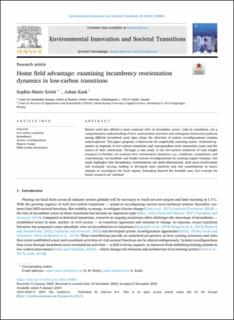| dc.contributor.author | Ertelt, Sophie-Marie | |
| dc.contributor.author | Kask, Johan | |
| dc.date.accessioned | 2024-04-05T12:45:07Z | |
| dc.date.available | 2024-04-05T12:45:07Z | |
| dc.date.created | 2023-12-22T15:15:10Z | |
| dc.date.issued | 2023 | |
| dc.identifier.citation | Environmental Innovation and Societal Transitions. 2024, 50, 100802 | en_US |
| dc.identifier.issn | 2210-4224 | |
| dc.identifier.uri | https://hdl.handle.net/11250/3125113 | |
| dc.description.abstract | Recent work has offered a more nuanced view of incumbent actors’ roles in transitions, yet a comprehensive understanding of how reorientation activities and subsequent interaction patterns among different incumbent actor types shape the direction of system reconfigurations remains underexplored. This paper proposes a framework for empirically assessing actors’ relational dynamics in response to low-carbon transitions and conceptualises actor interaction types and the nature of their interaction. Through a case study of the low-carbon transition of road freight transport in Sweden, we examine how reorientation dynamics, e.g., coalitions, competition, and contestations, can facilitate and hinder system reconfigurations by creating regime tensions. Our study highlights that incumbency reorientations are multi-dimensional, with actor involvement and strategies varying, leading to divergent actor positions and role constellations as actors attempt to reconfigure the focal regime. Extending beyond the Swedish case, five avenues for future research are outlined. | en_US |
| dc.language.iso | eng | en_US |
| dc.rights | Navngivelse 4.0 Internasjonal | * |
| dc.rights.uri | http://creativecommons.org/licenses/by/4.0/deed.no | * |
| dc.subject | Transport | en_US |
| dc.subject | Transportation | en_US |
| dc.subject | Case-studie | en_US |
| dc.subject | Case study | en_US |
| dc.subject | Lavutslipp | en_US |
| dc.subject | Low-emission | en_US |
| dc.subject | Energi | en_US |
| dc.subject | Energy | en_US |
| dc.subject | Systemanalyse | en_US |
| dc.subject | System Analysis | en_US |
| dc.subject | Grønn innovasjon | en_US |
| dc.subject | Green innovation | en_US |
| dc.subject | Forskning på overganger | en_US |
| dc.subject | Research on Transitions | en_US |
| dc.title | Home field advantage: examining incumbency reorientation dynamics in low-carbon transitions | en_US |
| dc.title.alternative | Home field advantage: examining incumbency reorientation dynamics in low-carbon transitions | en_US |
| dc.type | Peer reviewed | en_US |
| dc.type | Journal article | en_US |
| dc.description.version | publishedVersion | en_US |
| dc.rights.holder | © The Author(s) 2023 | en_US |
| dc.subject.nsi | VDP::Bedriftsøkonomi: 213 | en_US |
| dc.subject.nsi | VDP::Business: 213 | en_US |
| dc.source.pagenumber | 23 | en_US |
| dc.source.volume | 50 | en_US |
| dc.source.journal | Environmental Innovation and Societal Transitions | en_US |
| dc.identifier.doi | 10.1016/j.eist.2023.100802 | |
| dc.identifier.cristin | 2217342 | |
| dc.source.articlenumber | 100802 | en_US |
| cristin.ispublished | true | |
| cristin.fulltext | original | |
| cristin.fulltext | original | |
| cristin.fulltext | original | |
| cristin.fulltext | postprint | |
| cristin.qualitycode | 2 | |

